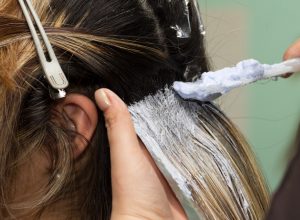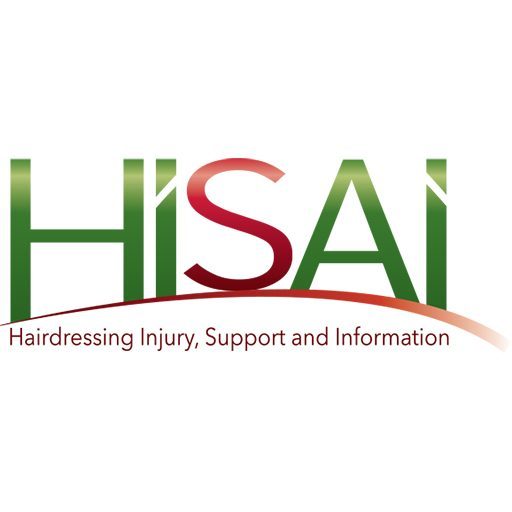Bleach

aka Lightner, Pre-Lightner, Lifter
A bleaching agent acts on the hair primarily to decompose a part of the melanin granules. Powder- bleaches use formulations containing persulfate salt(s) in powder form and a liquid or cream containing hydrogen peroxide which are mixed before use. For efficient bleaching these products are formulated so the mixture has a high pH (maybe 10-11) and often contains an ammonium salt that provides ammonia. This mixture causes a significant oxidation process that destroys the chromophore (colour pigments) of hair. A side reaction with the hair proteins and other components of the hair coincides and causes unwanted damage at the same time.
Studies show that hydrogen peroxide, the principal component of hair bleach systems, reacts faster with melanin than with hair proteins. However, because hair is primarily made of protein fibres and contains many molecules that react with oxygen (e.g., disulphide bonds of the cortical matrix and the cuticle), degradation of hair proteins also occurs during bleaching.
Chemical bleaching with hydrogen peroxide weakens the hair’s protein-membrane complex and oxidises the disulphide bonds of cysteine to its irreversible and un cross-linked form Cysteic acid. This breakage of the disulphide linkage causes the hair to become more hydrophilic and weaker when hair becomes brittle, it is this Cysteic acid (or say the loss of these disulphide linkages) that is the result, when too much of the hair’s proteins, has undergone an irreversible chemical change.
The extent of this breakdown does vary depending on the quality of hair, the strength of the oxidising agent, other ingredients in the formulations, the temperature used to process the bleach and the time the bleach is in contact with the hair. Generally, the greater the degree of lightening the greater the damage.
Studies show that 15 to 25% of the disulphide bonds in human hair maybe degraded during “normal” bleaching. However, A bleaching agent may break as much as 45% of the disulphide bonds during severe “in practice” bleaching. This latter amount of damage may occur while processing bleached hair a second time or while bleaching hair from black or brown-black to light blond.
National Occupational Standards have been written for bleaching services and can be viewed via the website: https://www.ukstandards.org.uk
Bleach FAQ:
Why use bleach?
To change the colour of a person’s hair, strip out previously dyed hair, and make hair lighter than it was.
Damage from a bleaching product is the most common reason for hair damage and scalp burns in a hairdressing environment.
The persulphate-based bleach used usually is mixed with an oxidising agent (hydrogen peroxide) at different strengths according to what is trying to be achieved.
The time stated by the manufacturer for safety varies, but the hairdresser should factor application time and processing time into the process together. The product starts processing once the product is in contact with the hair.
If you have your hair bleached regularly, emphasis should be only on new growth hair since repeated treatments can lead to hair breakage, which usually occurs at the junction of the new growth and previously treated hair.
Careful application to new growth only and previous conditioning of the hair can help prevent excessive breakage.
Will my hair always become damaged when bleach is used?
To a degree, yes, sometimes the damage is acceptable and does not cause significant or noticeable effects. Still, the chemical process would have weakened the fibres, regardless of the bleach used or the products used during/afterwards.
Unfortunately, suppose the hairdresser is not vigilant, leaves the product on for too long, uses improper hydrogen peroxide, or applies the bleach to already weakened hair (pre-bleached hair). In that case, the damage can become too great for the hair fibres.
The effect of bleach on hair is not binary (yes, it has damaged it, no it has not); as soon as bleach is applied to hair, it starts to damage the fibres; the questions is if the damage is:
Acceptable – The person accepts the level of damage for the colour achieved; the hair may feel processed but not over-processed.
Unacceptable – The hair has been over-processed and begins to feel inferior, gradually breaks or is an incorrect colour. The hair may become significantly damaged through the general day to day processes to the hair (washing, brushing etc.) that would usually have no impact on hair.
Catastrophic – The hair breaks immediately after applying the bleach, leaving no doubt as to the damage caused.
The hair becomes more damaged the more times it is processed and the greater the time it is processed. As the hair cannot repair itself, each of these processes causes permanent damage. Applying the same bleaching product to already processed hair would exacerbate the same chemical process and compound the damaged hair through the same process.
My hairdresser added something to the bleach and said the bleach wouldn’t damage my hair?
This is incorrect; Products sometimes termed ‘Bond-builders’ are used by hairdressers to negate the damage bleaching can do; what we know is these products may help make hair feel better if bleached. One theory is that they can slow the rate of oxidisation of the bleach and so delay the damage caused.
Some product nullifies metal ions in the hair, which accelerate the effect of bleach to the hair, e.g., we find areas with a high level of copper in the water, the bleaches affect the hair quicker, which can speed up the hair bleaching process.
By adding some of these ‘bond-building’ product, this reaction can be reduced to an extent.
However, these products do not stop the effect of the bleach on the hair, and they should not be used to counter the impact of the bleach entirely.
My hair started breaking several days after it was bleached. Is this still the cause?
It is possible. There are three types of bonds which are important in understanding this problem; the strong disulphide bonds and the less strong but more abundant Amide bonds and weak and very abundant Hydrogen bonds, the latter are electrostatic bonds are formed and re-formed when the hair is wet, then dried.
Severe bleaching can degrade both the disulphide and amide bonds leaving the the weaker hydrogen bonds being the main thing keeping the hair together, so once the hair becomes wet again, hydrogen bonds naturally break and then the actual damage to the hair becomes apparent.
Cosmetic techniques of smoothing the hair and products applied to mask the damage are removed when the person rewashes their hair, exposing the hydrogen bonds to water, revealing the extent of the damage.
My hairdresser said the damage was due to the product I have been using/not using
Using ‘the wrong’ shampoo can make your hair ‘feel’ dry but cannot cause hair damage.
Certain shampoos can help with damaged hair, they gum up cracks, smooth down cuticles and generally make it feel better. Still, shampoos and conditioners cannot ‘repair’ i.e., reform broken disulphide bonds or reverse significant hair damage caused by bleaching.
The use of the ‘wrong shampoo’ will not cause hair to break.
Can the hair ever be repaired?
‘Repair’ is an overused word in the cosmetic industry, and it does not mean the same thing as you think.
When you hear the word repair, think ‘make better than it is and not ‘make as new/repair/reverse all physical damage’. Some repair claims may rely on the hair looking better after application of the product.
You may use cosmetic products after the hair has been damaged to make it feel better, but the damage caused by a bleaching agent is permanent to the hair fibres it has touched.
Most severe damage will either be cut out or grow out.

